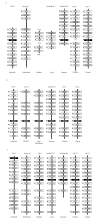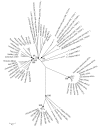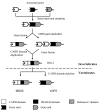Origin and evolution of the RIG-I like RNA helicase gene family
- PMID: 19400936
- PMCID: PMC2686710
- DOI: 10.1186/1471-2148-9-85
Origin and evolution of the RIG-I like RNA helicase gene family
Abstract
Background: The DExD/H domain containing RNA helicases such as retinoic acid-inducible gene I (RIG-I) and melanoma differentiation-associated gene 5 (MDA5) are key cytosolic pattern recognition receptors (PRRs) for detecting nucleotide pathogen associated molecular patterns (PAMPs) of invading viruses. The RIG-I and MDA5 proteins differentially recognise conserved PAMPs in double stranded or single stranded viral RNA molecules, leading to activation of the interferon system in vertebrates. They share three core protein domains including a RNA helicase domain near the C terminus (HELICc), one or more caspase activation and recruitment domains (CARDs) and an ATP dependent DExD/H domain. The RIG-I/MDA5 directed interferon response is negatively regulated by laboratory of genetics and physiology 2 (LGP2) and is believed to be controlled by the mitochondria antiviral signalling protein (MAVS), a CARD containing protein associated with mitochondria.
Results: The DExD/H containing RNA helicases including RIG-I, MDA5 and LGP2 were analysed in silico in a wide spectrum of invertebrate and vertebrate genomes. The gene synteny of MDA5 and LGP2 is well conserved among vertebrates whilst conservation of the gene synteny of RIG-I is less apparent. Invertebrate homologues had a closer phylogenetic relationship with the vertebrate RIG-Is than the MDA5/LGP2 molecules, suggesting the RIG-I homologues may have emerged earlier in evolution, possibly prior to the appearance of vertebrates. Our data suggest that the RIG-I like helicases possibly originated from three distinct genes coding for the core domains including the HELICc, CARD and ATP dependent DExD/H domains through gene fusion and gene/domain duplication. Furthermore, presence of domains similar to a prokaryotic DNA restriction enzyme III domain (Res III), and a zinc finger domain of transcription factor (TF) IIS have been detected by bioinformatic analysis.
Conclusion: The RIG-I/MDA5 viral surveillance system is conserved in vertebrates. The RIG-I like helicase family appears to have evolved from a common ancestor that originated from genes encoding different core functional domains. Diversification of core functional domains might be fundamental to their functional divergence in terms of recognition of different viral PAMPs.
Figures







Similar articles
-
Expression and functional characterization of the RIG-I-like receptors MDA5 and LGP2 in Rainbow trout (Oncorhynchus mykiss).J Virol. 2011 Aug;85(16):8403-12. doi: 10.1128/JVI.00445-10. Epub 2011 Jun 15. J Virol. 2011. PMID: 21680521 Free PMC article.
-
Pathogen recognition receptors in channel catfish: II. Identification, phylogeny and expression of retinoic acid-inducible gene I (RIG-I)-like receptors (RLRs).Dev Comp Immunol. 2012 Jul;37(3-4):381-9. doi: 10.1016/j.dci.2012.02.004. Epub 2012 Feb 28. Dev Comp Immunol. 2012. PMID: 22387588
-
RIG-I-like receptors evolved adaptively in mammals, with parallel evolution at LGP2 and RIG-I.J Mol Biol. 2014 Mar 20;426(6):1351-65. doi: 10.1016/j.jmb.2013.10.040. Epub 2013 Nov 7. J Mol Biol. 2014. PMID: 24211720
-
Proofreading mechanisms of the innate immune receptor RIG-I: distinguishing self and viral RNA.Biochem Soc Trans. 2024 Jun 26;52(3):1131-1148. doi: 10.1042/BST20230724. Biochem Soc Trans. 2024. PMID: 38884803 Free PMC article. Review.
-
LGP2 synergy with MDA5 in RLR-mediated RNA recognition and antiviral signaling.Cytokine. 2015 Aug;74(2):198-206. doi: 10.1016/j.cyto.2015.02.010. Epub 2015 Mar 18. Cytokine. 2015. PMID: 25794939 Free PMC article. Review.
Cited by
-
Analysis of Porcine RIG-I Like Receptors Revealed the Positive Regulation of RIG-I and MDA5 by LGP2.Front Immunol. 2021 May 18;12:609543. doi: 10.3389/fimmu.2021.609543. eCollection 2021. Front Immunol. 2021. PMID: 34093517 Free PMC article.
-
Functional characterizations of RIG-I to GCRV and viral/bacterial PAMPs in grass carp Ctenopharyngodon idella.PLoS One. 2012;7(7):e42182. doi: 10.1371/journal.pone.0042182. Epub 2012 Jul 31. PLoS One. 2012. PMID: 22860079 Free PMC article.
-
Chicken MDA5 senses short double-stranded RNA with implications for antiviral response against avian influenza viruses in chicken.J Innate Immun. 2014;6(1):58-71. doi: 10.1159/000351583. Epub 2013 Jul 13. J Innate Immun. 2014. PMID: 23860388 Free PMC article.
-
Insight into buffalo (Bubalus bubalis) RIG1 and MDA5 receptors: a comparative study on dsRNA recognition and in-vitro antiviral response.PLoS One. 2014 Feb 26;9(2):e89788. doi: 10.1371/journal.pone.0089788. eCollection 2014. PLoS One. 2014. PMID: 24587036 Free PMC article.
-
Melanoma differentiation-associated gene 5 in zebrafish provoking higher interferon-promoter activity through signalling enhancing of its shorter splicing variant.Immunology. 2014 Feb;141(2):192-202. doi: 10.1111/imm.12179. Immunology. 2014. PMID: 24116956 Free PMC article.
References
-
- Venkataraman T, Valdes M, Elsby R, Kakuta S, Caceres G, Saijo S, Iwakura Y, Barber GN. Loss of DExD/H box RNA helicase LGP2 manifests disparate antiviral responses. J Immunol. 2007;178:6444–6455. - PubMed
-
- Yoneyama M, Kikuchi M, Matsumoto K, Imaizumi T, Miyagishi M, Taira K, Foy E, Loo YM, Gale M, Jr, Akira S, Yonehara S, Kato A, Fujita T. Shared and unique functions of the DExD/H-box helicases RIG-I, MDA5, and LGP2 in antiviral innate immunity. J Immunol. 2005;175:2851–2858. - PubMed
-
- Holm GH, Zurney J, Tumilasci V, Leveille S, Danthi P, Hiscott J, Sherry B, Dermody TS. Retinoic acid-inducible gene-I and interferon-beta promoter stimulator-1 augment proapoptotic responses following mammalian reovirus infection via interferon regulatory factor-3. J Biol Chem. 2007;282:21953–21961. doi: 10.1074/jbc.M702112200. - DOI - PubMed
Publication types
MeSH terms
Substances
LinkOut - more resources
Full Text Sources
Other Literature Sources
Miscellaneous

